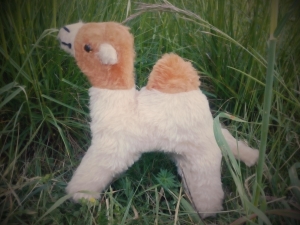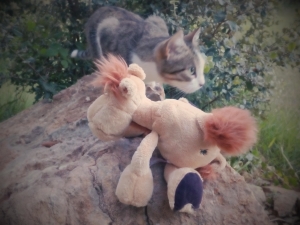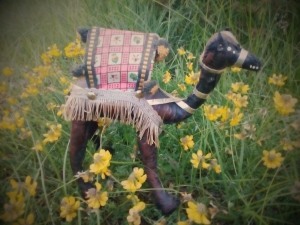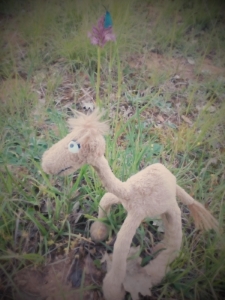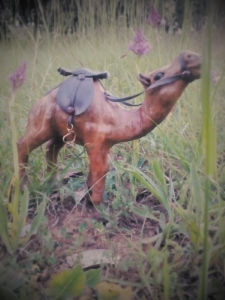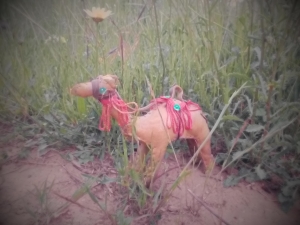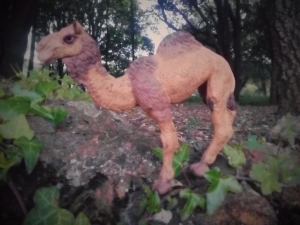 |
 |
 |

Informations and extracts derived from the definition of the Dictionary of Speech-Language Pathology of F. Brin, C. Courrier, E. Lederlé,
V. Masy. Editor: L'ORTHO-édition. p102.103.104 :
Language can be commonly defined as a system of signs to promote communication between beings.
The reality of its definition is in fact very complex since it concerns various disciplines:
- it is a physiological act (realized by different organs of the human body),
- psychological (assuming the voluntary activity of thought),
- social (allowing communication between men).
- But it is also a historical reality observed throughout the world, at different times and in different aspects.

♦ From a historical and anthropological point of view, ... According to some anthropological research, the
differentiation between the genus Homo and the Australopithecus will be about 4 to 5 million years. But it is only much later
(-2.2 million years ago) that Homo habilis, who already makes tools himself, hunts and lives in society, appears, which testifies
to a capacity of symbolization and the emergence of a consciousness. During this long period, climatic changes ... force the
species to adapt, to move (nomadisation) and to develop more and more specific skills: transfer of experience, production
receipts, Group activities, ...
Correlatively, at first, the temporal region and the area of Broca develop. Then the endocranial volume and capacity of the
brain increase, giving Homo habilis a more and more "human" front. Its toothing harmonizes (omnivorous feeding), the diversification
of the tools it produces testifies to the increasing complexity of its representations. Finally, the environment, dangerous for
his survival, forces him to solidarity and to regroup (life in society) and it is also in this way that seems to develop the faculty
of language (obviously it is a communication by gestures, anterior to that of codes of cries). However, the most cautious anthropologists
date the faculty of language, or at the time of the appearance of Homo erectus, between -1.5 million years and -200,000 years,
during which time the capacity of the endocranium is doubled and myelinization and cerebral vascularization increased, or even
later, between -200 000 and -30 000 years with the appearance of Homo sapiens. Indeed, traces of worship, burials, and ritual
symbolism (inscriptions) tend to prove that the emergence of the faculty of language results from the link between innate aptitudes
and the environment and history, the development of the neo-cortex Already signing the presence of a conceptual thought.
At the same time, it is indisputable that verticalization due to bipedalism leads to anatomical, neurological changes (the baby's
vertical port in the mother's womb influences the shape of the skull and the development of the brain), functional and social.
The verticalization, on the one hand releases the hands (grip, work activities, gestural communication ...), on the other hand
resonates with the anatomical and functional planes of the whole body, and in particular of the Facial and oro-pharyngo-laryngeal
areas (lowering of the larynx, separation of the nasal cavity and the oropharynx by the palate ...), the larynx and the oral cavity
thus finding new potentialities allowing the progressive emergence of language Articulated, speech and language...

♦ From a philosophical point of view:
... man has always been interested in language, since it is through language that he manages to understand how the world
articulates and to better understand himself. Socrates seeks to define words (permanence of meaning), Plato reflects on their
relations in the sentence ..., Aristotle on the links between logical laws and language ... Then the dialectic of the medieval ...
the theory of signs In the 18th century (Rousseau, Condillac: the signs of language are the foundation of abstract and reflexive thought) ...

♦ From a psycholinguistic point of view, Language is a symbolic activity which makes it possible to construct a substitute detachable from reality: it corresponds to a
symbolic activity of meaning. But language is not "directly" observable, and its access passes through the languages in which it
is realized. It is through his learning and his appropriation of the language, whatever it is, that the child will put the language
into operation and will have a symbolic activity of meaning: he will learn to speak by learning the language and Constructing the
language ...

♦ From a linguistic point of view:
We will retain the opposition of Saussure langue / parole and Emile Benveniste who, although his heir will partly detach himself
by posing "the instance of discourse" ... He gives language the following definition: "Language represents the form The highest
of a faculty which is inherent in the human condition, the faculty of symbolizing.By this we mean, very broadly, the ability to
represent the real by a "sign" and to understand the "sign" as the representative of the real, and therefore to establish a
relation of "meaning" between something and something else " .
Chomsky introduces transformational linguistics: it is the notion of competence that is at the heart of linguistic activity
(knowing how to use a language by producing an infinite number of sentences using a finite number of elements belonging to the
Structure of the language) including the speaker.

♦ From a developmental point of view:
The development of language begins at birth and even before (in utero).
On the one hand, it results from the child's ability to symbolize, on the other hand, from the stimuli brought by the entourage,
and its construction is closely linked to the intellectual, motor, perceptive, psychoaffective structuring of the child
considered in his whole ...
♦ Order of appearance of illustrations representing the Tower of Babel: 1) François de Nomé (XVIIIème S); 2) Hendrick van Cleef (XVème S)
3) Lucas Van Valckenborch (1594); 4) Pieter Bruegel l'ancien (1563); 5) Pieter Bruegel l'ancien; 6) Lucas Van Valckenborch
R. Jakobson ( 1896-1982), a Russian linguist, was very interested in this aspect of language and defined as many functions as components in his
communication scheme.
It defines 6 pragmatic functions of the language:
♦ The expressive or cognitive function is centered on the transmitter and shows that the language serves to inform the
interlocutor.
♦ The conative function imposes a determined behavior on the recipient.
♦ The metalinguistic function shows that one reasoning on the code.
♦ The poetic function gives a creative value to the message.
♦ The purpose of the phatic function is to maintain contact between the interlocutors.
♦ The referential function considers the referent (what is referred to) as the central element of communication.

THE BLOOM AND LAHEY MODEL:
This model conception, which appeared to the authors in 1973, is an interactionist model in three currents: linguistic, cognitive and socio-linguistic,
This model consists of a focus on language competence at the intersection of three components: The Form of language : How to say ? The Contents : What to say ? The use : Why say ?
According to Lahey (1988), these three components first develop independently and are integrated around 12 months, allowing the appearance of linguistic communication.
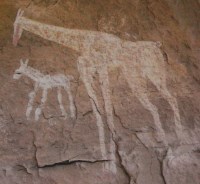
FORM :
Verbal linguistic form: articulation, phonology, syntax, morphosyntax, production of utterances and narratives,
The conventional form belongs to the members of the same linguistic community,
Non-verbal form: mimogestuality
This is the "HOW TO SAY"

CONTENT:
Active and passive lexicon, comprehension, content categories.
It is the representation that one can have of the world, it depends on our own experiences. It varies according to the individual
and is closely linked to cognitive development but also to the environment and culture.
This is the "WHAT SAY"
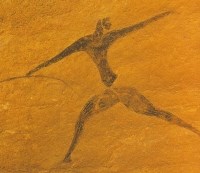
:USE :
Acts of speech, acts of language, conversational rules, adaptation to the interlocutor. Verbal and non-verbal signals.
It is pragmatic. Pragmatics would be the driving force behind the choice of language units for comprehension and expression (CRONK.C),
This is the "WHY SAY"
♦ Cave paintings: Giraffe: Lybia, site Tirarite; Dromedary: Jordan, Wadi Rum; Archer: Algeria, Site of Jabbaren, Tassili of Ajjers.
♦ The speech therapist has a wide range of assessments of language, many of which are very specific to certain aspects
of language. The speech-language pathologist knows how to adapt to the patient's complaint or difficulties and chooses the type
of assessment to be used and the additional tests to be carried out in more specific fields in order to isolate the nature of
the disorders. The re-educative framework is then drawn.
♦ Dame Sarrasine here isolates some aspects of the language of the very young child by inscribing them in the model Bloom and Lahey.
This choice will allow each parent to better understand the language of their young child, but is also underpinned by the attempt
to better understand animal language in what it bears explicit as well as human-animal communication where everyone Partners
must advance in understanding the language of the other.
The items of the selected subjects will be partly included in the animal language section of this site.

A) HOW YOUR CHILD COMMUNICATES
Center Honen. A.MANOLSON.1997 :
- Level I
Crying
By blowing
Shouting
By making vocal sounds
Looking at
By doing disorganized gestures with arms and hands.
- Level II
By making facial expressions
Laughing
By producing all sorts of vocalic and consonantal sounds
Extending the arms
- Level III
Shaking his head to say yes or no
In seeking to make eye contact
By pointing fingers and making gestures
By miming what he means
By producing sounds that take the place of words
By occasionally using isolated words
- Level IV
By often using isolated words
By combining words (difficult to understand)
By combining two or more words
Using sign language or a communication board
Each attitude of communication deserves to be studied through the various functions of the "why the child communicates"

A) CONCEPT OF CONTENT
Dame Sarrasine first of all chooses her notions. To know the subject if:
Grille des Dames Agnès BO and Laurence Kunz, Speech therapists:
He uses existence: there is
He uses non-existence: there is no
He uses the term "again"
He has the notion of disappearance: there is no more.
He has the notion of lack: it is lacking.
He has the notion of negation: broken, not broken
He has the notion of internal state: I am ill, I am tired
He has the notion of external state: it is cold ..., it is difficult
He has the notion of possession: it is to me
He has the concept of quantity
He has the notion of causality: because, because of
He has the notion of time: tomorrow, after, yesterday ...
He has the notion of coordination: and, with, but ..
He has the notion of localization: here, above, outside...
He has the notion of action (uses conjugated verbs)
B) UNDERSTANDING STRATEGIES:
Khomsi's O-52 assessment highlights the complexity of understanding strategies used by the child:
- Pragmatic strategies: understanding the statement based on what the child knows about reality. Before 3 years.
- Lexical strategies: the utterance is entered from a word in the sentence. 0 to 3 years.
- Morpho-syntactic strategies: the utterance is entered from the relationship between two elements of the sentence.2-5 years.
- Narrative strategies: the utterance is grasped by the treatment of the temporal and causal succession. 4 to 7 years.
- Meta-discursive strategies: accept the non-communicational value of the utterance; Decenter from the utterance. After 7 years.
Moreover, in order to make another link with written language, it is important to note that to enter written language, the child
must be able to use inferential strategies (narrative + meta-discursive strategies).
C) SUBJECTS OF CHILD COMMUNICATION
It should be noted how frequently the child communicates about each of the topics listed, namely: When: "Always - Often - Sometimes - Never"
Remember that the child can communicate through body attitudes, sounds, sign language, a communication board or words.
Grille of Honen center , A. Manolson 1997 :
THEMES
- Food or drink
- Toys
- Clothing
- Pets
- Other objects
- Parents
- Brothers and sisters
- Kinship
- Friends
- Neighbors
- Teacher
- Nurse
- Other people
- Eat
- Wash yourself
- Play
- Go for a walk
- Watch the television, internet
- Listen to music
- Other activites
- Dame Sarrasine adds: the need for cuddling, tenderness.

A) FUNCTIONS: WHY CHILDREN COMMUNICATE
Draws attention
Ask for help
Makes requests
Protests
Appointed
Gives an instruction
Ask a question
Answer a question
Expresses a need
Expresses a feeling
Comment on what he sees or does
Reports a fact
Dame Sarrasine adds here: not to feel alone
B) PRAGMATIC PRECURSORS AND JOINT REFERENCE
CLSC Quebec Region "Apprentices in the country of communication" 2002.
In each case, it is necessary to evaluate the item according to the following qualifiers: frequent, emergent, rarely.
Establishes eye contact spontaneously
Can make visual contact on request
Maintains eye contact
Maintains eye contact
Is able to joint attention "object-person" alternately
Respect the turn in the game
Interested in his or her interlocutor, the verbal message
Respect the turn of speech
Initiates episodes of joint engagement - not verbally
- verbally
C) SEMANTIC PRECURSORS
Recognizes familiar objects
Functionally uses the objects presented to it
Stage of play: - exploratory (simple manipulation) - combinatorial - symbolic
Has an expressive vocabulary of about ... words
The grammatical categories are: - substantives - verbs (action-state) - adjectives
D) FORMAL PRECURSORS
Imitates daily actions, actions
Points
Shouts, cries
Jargonne
Imitates sounds, words
E) COMPREHENSION
- Includes contextual, non-verbal cues
- Includes an isolated word and a simple instruction in context
- Contains in context the question "where", "who" "what"

| AGE | COMPETENCIES-SOCKS FOR COMMUNICATION AND LANGUAGE NON-VERBAL AND VERBAL COMMUNICATION | PERCEPTION COMPREHENSION | PRODUCTION EXPRESSION | OTHER COMPETENCES: VISION, MOTRICITY CONDUCT WITH OBJECTS; PERMANENT OBJECT, GAME, SYMBOLIC GAME | WARNING SIGNS AT LANGUAGE LEVEL |
| OF BIRTH AT 2 MONTHS | Reacts to voice. | Sighs, guttural sounds, vegetative sounds translating comfort or discomfort. | Setting up the look. | ||
| 2 MONTHS | Reacts to surrounding noise. | Vocalizations of sounds with opening and closing of the mouth. | Visual tracking. | ||
| 3 MONTHS | First intentional smiles. Capacity for non-verbal requests (tone, motor skills) | Small cries, "AREU", "A E". Sounds of the back "G". | Visual tracking at 180 °. Holds his head; carries to the mouth; Sensitivity to the world of people, things, actions. | CAUTION IF at 3 months there is no eye catch. | |
| 4 MONTHS | Easy to sound. Returns vocalizations (each turn, pre-conversation). Laughs with shrapnel. Beginning episodes of joint attention. Momentum for interaction (demand for communication with others). | Stop crying when you talk to him. | Vocal sounds. | The object is taken, dropped, resumed; He discovers his body, explores, pulls, feels. | CAUTION IF the child does not spontaneously speak when handling objects. |
| 5 MONTHS | Begins to react to "no". | Variation sets of intonations; Begins to respond to his name by vocalizations; First consonants: P, B, M then W; K. | Voluntary grip of an object; Explores toys of different textures and colors; Turns, shakes, touches, scrapes, supports objects. | ||
| 6 MONTHS | Coos. Vocalizes in front of the toys. He vocalizes in front of his image in the mirror. | Canonical canonization (production with intonation of duplicated syllables "bababa, mamama"). | He looks at the person talking to him. New capacities for non-verbal requests. Motor imitation ability | CAUTION IF : - the child does not participate in the episodes of joint attention. - the setting of the look and the visual follow-up are not done. - the child's productions are rare and poor. |
|
| 7 MONTHS | Reacts well to "NO". Gives an object on request. | Continuation of babbling. The vowels produced conform to those of the mother tongue. | He sits without support. He can detach his hand from the ground to catch an object. He knows how to make an object pass from one hand to the other. He plays to throw away the objects. He starts no longer to mouth. Beginning of the "cuckoo". | ||
| 8 MONTHS | Capacity for turning and exchanging. Ability to use communicative gestures. Verbal imitation ability. Imitated with the intonative contour. More and more mimics (joy, fear, disgust, pleasure). | He understands "NO" "BRAVO" "REVIEW". | Enrichment of canonical babbling with various sequences of syllables (exemple "baga"). | Game of the "cuckoo". | |
| 9 MONTHS | Begins to use symbolic gestures. He does "no" with the head. | Stops when you say "no". Beginning of comprehension of familiar words in context then recognition of words known out of context. | Continuation of babbling with various sequences. | He crawls. Thumb-index finger. Uses objects in a functionally adapted way. Game of the "cache-cache" (the missing object is searched). | CAUTION IF at 9 months the child seems indifferent to everything. CAUTION IF at 9-10 months: - He does not spontaneously imitate the sounds, the cries of animals. - He does not imitate new words. |
| 11-12 MONTHS | Ability to use scoring. Ability to recognize the mimicry of others. Begins to mimic actions on the stuffed animals. | Ability to understand non-verbally. Understanding about thirty words in context and out of context. | Babbling even more varied "as if the child was telling." Appearance of the first words (stable productions in relation to situations). | Moves on 4 legs. Try to stand up by grabbing the furniture. Scribble with a big pencil. | ATTENTION If the canonical babble is absent or has disappeared |
| 12-15 MONTHS | Understanding of very simple little sentences (ex: daddy left). | Appearance of the first words. Appearance of consonants "f" "v" "l". | Almost no longer to the mouth. Walk, held by both hands, then by one hand, then alone. | CAUTION IF: - the child realizes only a few representational gestures, sequences of gestures, gestures complementary to isolated words. - The child has not yet babbled in a canonical way. - Babbling does not diversify or disappears without being replaced by words. - The child has a movement disorder (holding of the head, sitting position, movement in space). |
|
| 16 MONTHS | Increasing conversational exchanges with the child. He responds to simple verbal instructions by action. | Includes 100 to 150 words. Includes more and more short sentences in situation. | More and more words, about 50 mostly names + intonation babbling. | ||
| 18 MONTHS | Ability to use mimicry. | Understanding of more than 200 words. He points to many objects on request. He points to an image. He obeys small instructions of 1 or 2 elements without gestures. | He answers "no". Repetitions, imitation of words. Productions of +/- 50 words increasing. Production more and more verbs. Production of small agrammatical sentences of 2 or 3 words. | Tower of 2 cubes. Built-ins. Box forms "put in". Appearance of symbolic game. | CAUTION IF : - the symbolic game does not appear. - The child has not said words, does not seem to understand and has little interest in verbal exchanges. - He is late in performing activities requiring fine motor skills and oculomotor abilities. |
| 24 MONTHS | He understands more and more words and instructions. Understanding of more than 200 words increasing. He begins to point on certain parts of the body. He obeys instructions more and more complex. | Rapid increase in vocabulary (from 50 to 75 words or much more). He says his name. Appearance of short sentences. He uses the "me". | Tower of 6 or 7 cubes. Simple construction. First games to "pretend" especially in the presence of a model. | CAUTION IF : - The child has a delay in comprehension. - the child says less than 50 words. - The child uses an unvaried vocabulary with few verbs. - The child produces only 4/5 consonants. |
|
| FROM 2 TO 3 YEARS | Rapid increase of the vocabulary included (200 words and more towards 2 years and from 500 to 900 words towards 3 years).He includes "on / in / after / before". He includes some colors. He includes terms related to body and space "up / down / in front of you / behind you / standing / lying down / sitting. "He obeys the complex instructions" put the little teddy bear in the box. " | Accroissement rapide du lexique ( 50 à 75 mots vers 2 ans, puis 300 mots et plus vers 3 ans, de 4 à 10 nouveaux mots par jour. Fait des phrases de 3 à 4 mots avec verbes et adjectifs. Commence à utiliser des articles, à utiliser des prépositions indiquant la possession (à,de,pour). Commence à utiliser des adverbes. Pose des questions « quoi ? Pourquoi ? Où ? Quand? Qui ? " Demande « C'est quoi ça ? ». Utilise « moi » « je ». articulation construite à l'exception de quelques phonèmes complexes/ch, j,r / et le /L/ qui continue de se construire. | Games: Recesses. | CAUTION IF at 30 months: - The child does not use the prepositions "to" indicating the possessor, the "of" indicating the possession and the "for" indicating the beneficiary. - Pas d'association de mots. - L'enfant n'imite pas ( sans qu'on lui demande) les nouveaux mots, les combinaisons de 2 mots et les nouvelles structures syntaxiques. |
|
| 3 YEARS | Rapid increase of vocabulary included (1500 to 2000 words to 3 years 6 months and +/- 2500 words to 4 years). He shows almost all parts of the body. He understands "where, in front, behind, why, yesterday". He obeys a lot of complex instructions. | Rapid increase in vocabulary, from 250 to 450 words pronounced around 3 years, from 1000 to 1500 words to 3 years 6 months and more than 1500 words to 4 years. He uses personal pronouns. He uses the times. He makes sentences of 6 words and more. He uses the "I". He tells what he did. He describes what he sees. He begins to use spatial prepositions | Tower of 9 cubes. He puts big beads on a baguette.Bonhomme tadpole. He copies a circle and closes it. Games of "pretending" associating several actions. Rich symbolic games with a project that guides the action. | CAUTION IF : - No association of 3 words including a verb. - No articulation sufficient to be understood by all. - L'enfant ne pose pas de questions, ne commence pas à utiliser le « je ». - Il n'utilise pas les adverbes et prépositions spatiales. - L'enfant ne joue pas symboliquement. - L'enfant a du mal à contrôler les mouvements de ses lèvres, de sa langue. - L'enfant ne comprend pas au téléphone. - Pas de forte augmentation lexicale entre 3 et 4 ans. |
| AGE | PERCEPTION UNDERSTANDING | EXPRESSION PRODUCTION | OTHER ABILITIES |
| FROM 4 TO 5 YEARS |
He understands the questions: when? how? and the terms: between, in the middle, around. Notion of number and difference. He obeys instructions with objects not present. |
He uses the past and the future. He uses relative sentences. He plays with words, invents them. He asks a lot of questions. He begins to adapt his speech to his interlocutor. He begins to talk about his imagination. All the sounds of the language are acquired but the differentiation S, Z / CH, J remains to be clarified. |
Jumps well. He holds a few seconds in balance on one foot. He holds the pencil between thumb and forefinger. He draws a complete man. He copies numbers, letters, the triangle. He appreciates sizes, shapes and colors. |
|
During this preoperative period: Establishment of the symbolic function of language, deferred imitation, mental image, drawing,
symbolic games of pretense. The thought of the child is an egocentric and intuitive thought dominated by the perceptive aspect. |
|||
| FROM 5 TO 6 YEARS |
All language is understood with the main abstract words. He has the notions of lack and difference. He is interested in the meaning of words, no longer asks "what is it? But what does that mean? " Discriminates close sounds. He wants to learn to read. |
Production of complex sentences with expansion and concordance of times. Uses almost all notions of space and time. He can define and explain words. He tells in a clear and orderly way. |
He's lacing his shoe laces. He jumps up and climbs trees. Body diagram elaborated. Reproduces rhythms, copies his name and the rhombus. He classifies according to size and color criteria. |
| AFTER 6 YEARS |
As for time: learning seasons and months, date, notions of duration, time. |
Formulation of questions with use of negation and inversion of subject / verb. Continuous increase of the lexical stock. |
Writing Sits without the help of the hands. Acquisition of the reversibility of thought. Storage of the substance, weight, volume, spatial and numerical. Construction of elementary logical structures of classification and relation and number. |
|
End of the symbolic or preoperative period to 7-8 years and transition to the stage of preparation and organization of concrete operations. |
|||

Dame Sarrasine, having been for a time responsible for orthophonic prevention on a French department, transmits here the wise
advice that any speech therapist will give you.
Dame Sarrasine also relied here largely on the information gathered and contained in the support "Dialogoris: early speech-language
assessments. Prevention. For the child from 0 to 4 years old and his family." de P. Antheunis,
F. Ercolani-Bertrand, S. Roy- Orthophonistes. Ed Com-Médic.
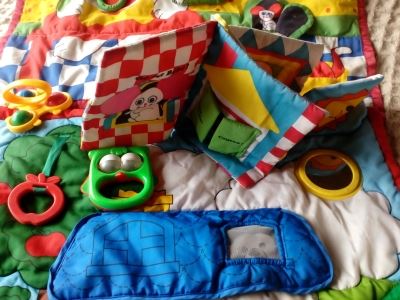
♦ LANGUAGE
Speak calmly, tenderly to your baby. Position yourself as much as possible in front of him.
Sing him nursery rhymes.
Laugh with him.
Explain to him the sounds he hears.
Name people and things around them.
Tell him what you are doing.
Avoid the pacifier, let it take the thumb if it wishes
- From 0 to 3 months:
Make him discover the pleasure of the language during the toilet, the change, the bottle, to calm it, to rock it,
Show him that we already communicate with the smile, the look, the mimicry, the caresses, the voice.
- From 3 to 6 months :
Listen carefully to your baby and answer him, you will teach him that one speaks each turn. Put him in a deck chair, talk to him,
explain what he does and what you do and the things around him.
♦ GAMES
- From 0 to 3 months :
Mobiles, rattles.
- From 3 months:
Play mats, soft toys, cloth toys.
♦ BOOKS
Books in fabric, plastic (book-baths) or very thick cardboard.
Let the baby lick, chew, throw, kick the book. It is the sensual pleasure that prevails, the book is source of sensory-motor experiences.
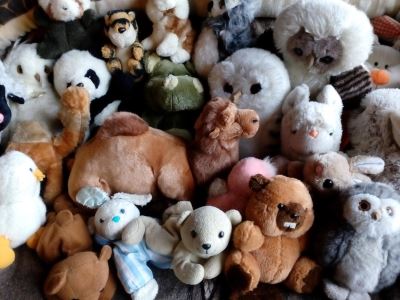
♦ LANGUAGE
Modulate your voice and intonations: it pleases the baby and allows him to better understand and use the language.
Make discover the pleasure of communicating, favor all forms of exchanges (look, grimaces, laughs, smiles ...)
Beware of television that turns into a sound environment and isolates, not promoting a real communication.
As soon as possible, read small books in cardboard or fabric to your baby.
- From 6 to 9 months :
Enjoy what he's watching, touching, telling him what's going on.
Encourage him in his little experiences, he learns causes and effects, things that are alike and different.
- From 9 to 12 months :
He needs to feel that he is listened to and understood, so it is important to play, to say the names of the things that interest
him, to translate with words what he wants to express by his facial expressions, showing you or by emitting syllables.
♦ GAMES
Portals and activity tables with mirror.
Toys with easy grips, bath toys, ball, cuckoo, hugs, tickling.
Use humor, dose activities: neither too long nor too many.
Create a relaxing universe.
Be attentive to his behavior which indicates his state of fatigue.
Let him choose his blanket.
♦ BOOKS
Under the supervision of an adult, offer magazines to manipulate, to tear.
Small thick cardboard books.
Do not hesitate to tell, the child is capable of joint attention, he can listen and watch a few moments and he likes to be
told the images. He loves the voices of his mom, his dad, his brothers and sisters, he loves to have his parents near him,
he understands more and more that the world is made of things and people very interesting.
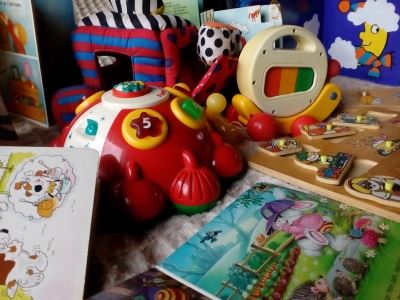
♦ LANGUAGE
- From 12 to 18 months :
The baby understands that the sounds of speech have a meaning: Receive with wonder his first little words limited to one syllable. If you try to understand it, if you give it the right word in your answer without asking it to repeat and if
you put the corrected word back in a little sentence, it will learn slowly and naturally.
Speak normally normally, using simple but not simplified words.
Talk to him about the colors and shapes that we see on all magazines, of course also in the environment, that interests him immensely.
- From 18 months to 2 years :
Enrich his vocabulary, it is important to talk to him about many different subjects: what he must do, what he can not do and
especially tell him about what is beautiful, what is good , what interests him, what he sees in a book or catalog.
Explain to him the words he does not understand.
If he pronounces badly, give him the correct form of the word, without obliging him to repeat.
It is important that he hears different patterns of sentences: sentences that give orders, that ask questions, that describe,
that express feelings. The child must feel that it is a pleasure to speak.
♦ GAMES
- toys to shoot and push.
- olfactory and taste games.
- basic building games.
- From 18 months: box shape.
Encourage and congratulate him when he succeeds.
Continue to comment on everything he does to show your interest and encourage the development of his language
♦ BOOKS
cardboard books, cloths, small magazines for children, coloring pages, picture books.
He begins to turn the pages of the book, he will start to better understand the images and make the link between the objects he knows he touches and manipulates and their representation on the image (in 2 dimensions).
The child will begin to point fingers, he takes pleasure in what he is called characters and things, he likes to tell, we start
again, he loves everyone turn.
He discovers his own body by turning the pages, moving his fingers to hold the book.
He is more and more interested in mimics, grimaces, feelings.

♦ LANGUAGE
- At this age the child is very curious, is interested in everything, asks a lot of questions, it is important to take the time to answer him.
- Teach him to say, to tell, help him to clarify his thoughts and feelings.
- He claims autonomy so it is important to give him the opportunity to do alone, to help him grow.
- It is normal that he still has trouble articulating certain sounds, always give him the model by repeating yourself the word
corrected in a sentence, without requiring him to repeat, the most important is to continue to discuss and that he hears the correct word.
- Encourage him to abandon the bottle, thumb or pacifier for those who still use them.
♦ GAMES
Games to catch, throw, jump, climb, pedal.
Manual games.
Hide and seek games.
Imitation toys, realistic accessories for "make-believe" games.
Puzzles.
Built-ins.
- Putting age-appropriate activities into his hands because if he fails too often, he may lose confidence in himself.
- Let him think, seek solutions alone, encourage him to seek solutions "what could you do for ...? ", Allow it to be wrong and that errors are formative and allow us to progress.
♦ BOOKS
Children's books (trust publishers for age groups), children's magazines, coloring, photo-books.
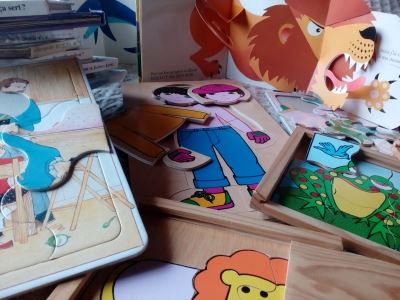
♦ LANGUAGE
Tell and read stories.
Read alone before them, children are sensitive to the example.
♦ GAMES
Games to catch, throw, jump, climb, pedal.
Manual games.
Hide and seek games.
Imitation toys, realistic accessories for "make-believe" games.
Puzzles.
Around 4 years old, first rules games (lotto, dominoes).
Patience games.
♦ BOOKS
Children's books (trust publishers for age groups), children's magazines, coloring, photo-books.
It's good if you have a little time each day to look at a book, a picture book.
The child becomes able to identify the events and the actions on the images, he makes the connection between his history, his
lived and what the images tell.
He develops his imagination, he makes connections, he shares more and more emotions with his parents.
He always likes to be talked to, told, told.
He discovers the creative character of the language, he sometimes plays with words.
He is more and more able to take into account the other, his thoughts, feelings other than his own.
He is moving towards written language: he educates his eye, he discovers with happiness a story, he is interested in letters.
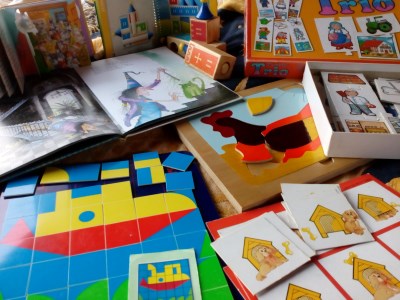
♦ LANGUAGE
Tell and read stories, enrich his vocabulary.
♦ GAMES
Building games, with characters, rules games, association games, difference games, patience games, games about space and time.
♦ BOOKS
Always and continue to trust publishers.
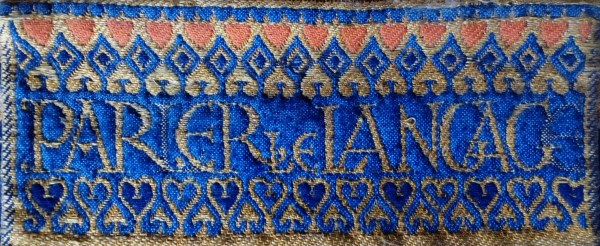
Tapestry Atelier de la Martinerie
♦ THE LANGUAGE IS, above all, A MEANS TO COMMUNICATE ITS NEEDS, ITS FEELINGS.
These tips can be found in a speech-language prevention folder "Parents, your child is learning to speak"
realized byN. Denni-Krichel, Speech-Language Pathologist since 1974 Teaching Speech-Language Pathologist at the Faculty
of Medicine of Nancy, President of the National Federation of Speech-Language Pathologists from 2004 to 2013; booklet enriched with examples,
for parents and edited by Ortho-Edition
